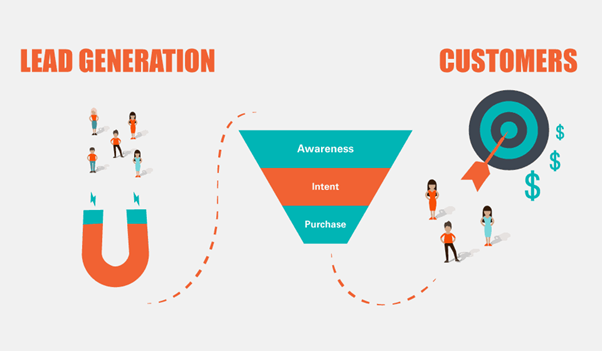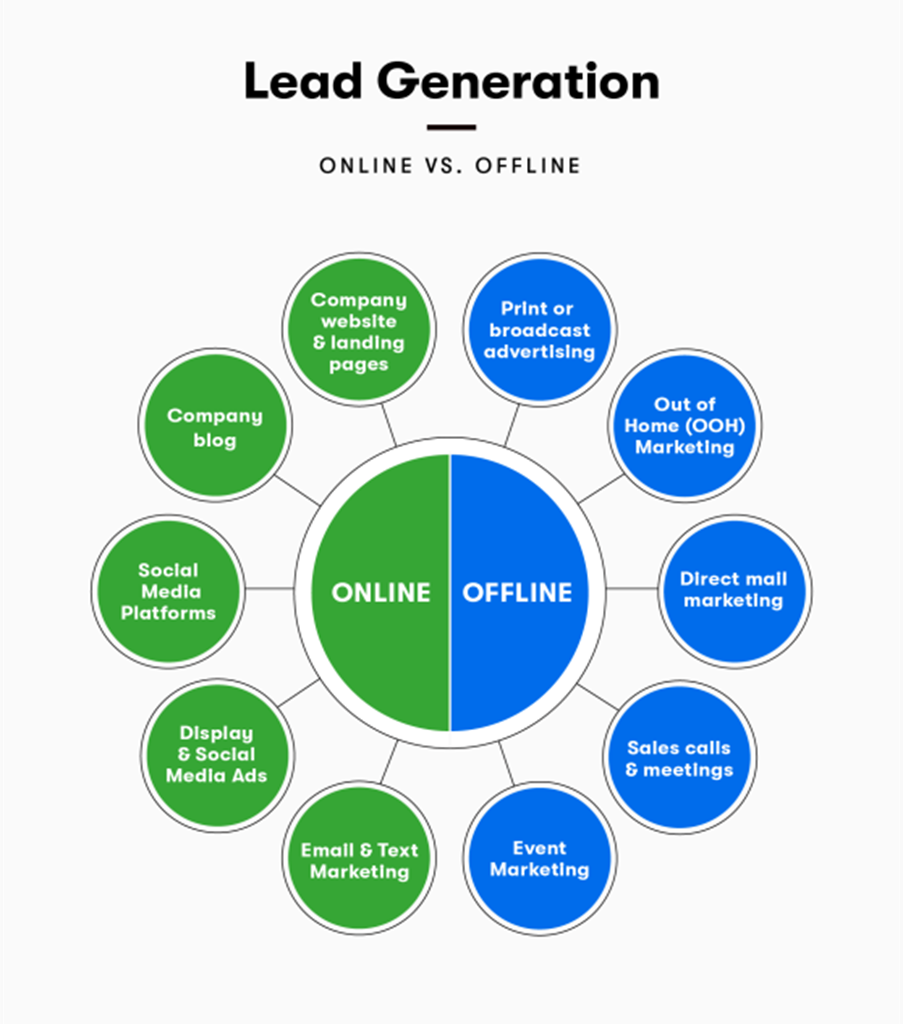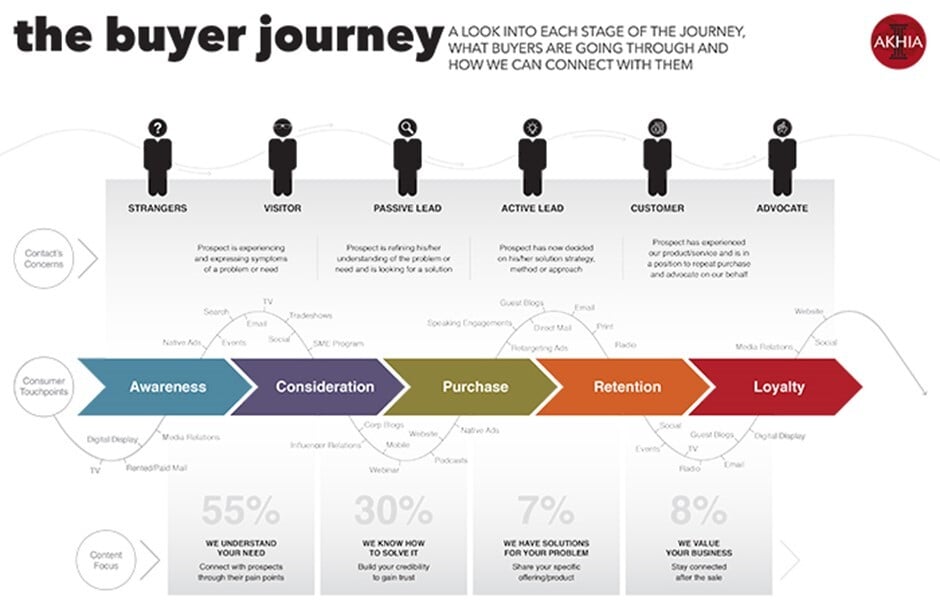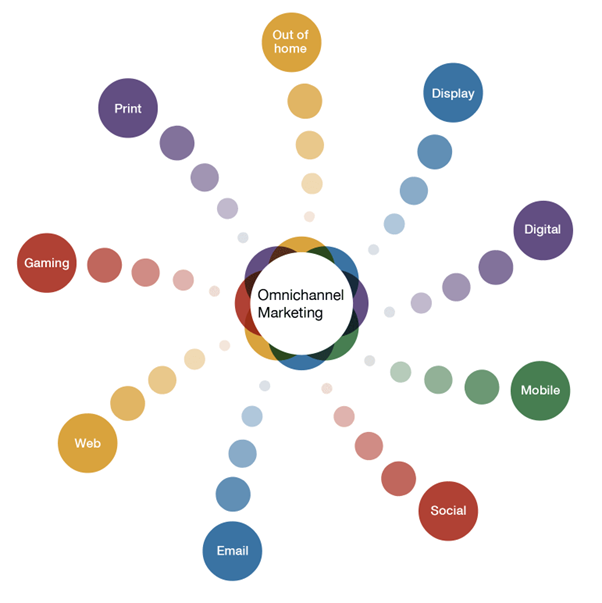A data-driven lead generation strategy can be a powerful tool for businesses to increase buyers and boost sales. By leveraging data-driven insights to identify target audiences and develop marketing campaigns, businesses can create personalized experiences that drive more leads and convert more clients. According to 78% of businesses, data-driven marketing improves client acquisition and lead conversion. This blog post will explore how businesses can leverage data-driven lead-generation strategies to drive their growth to the next level.

What is a data-driven Lead Generation Strategy?
Data-driven lead generation uses data to design an effective lead generation process. By leveraging insights gleaned from client data, you can develop a more effective lead-generation strategy that maximizes ROI, while minimizing wasted resources.
Define your target market. Identifying the company's decision-makers in your target segment is critical because it saves resources.
Gather data from multiple sources. The chances of conversion are directly proportionate to the size of the data. Therefore collect data such as email addresses or your client's preferences from as many sources as possible, including client reviews, web analytics, and competitive research.
Analyze your data carefully. Look for patterns and trends that can help you better understand the buyer journey of your target audience and what they're looking for.
Use your findings to improve your lead generation strategy. Based on what you've learned from your analysis, make adjustments to your lead generation strategy accordingly. This may involve changing up your generation strategies or personalization approach.

Benefits of data-driven lead generation strategy
By understanding who your ideal client is and what they’re looking for, you can create a strategy that will effectively attract leads that are more likely to convert. Here are some benefits of using a data-driven lead generation strategy:
Greater accuracy: When you have data to guide your decisions, you're more likely to make informed decisions that accurately reflect your target market.
More efficient use of resources: A data-driven approach allows you to focus on the lead generation process which is more efficient and ensures that you're making the most of your time and effort on leads that are best fit and convertible.
Increased ROI: Because data-driven lead generation strategies offer more effectiveness and efficiency, they tend to have a higher ROI than other approaches.
Understand the Buyer’s Intent to drive growth
Intent-based leads are buyers who are demonstrating behaviors that indicate they are actively seeking solutions that match your offerings.
There are a few different ways to go about understanding the buyer’s intent based on
Search query pattern: Analyze the keywords they use and the kind of information they are seeking from their search query to identify what they require and their desire
Behavior on-site: Next, examine their behavior on your website to identify their preferences and their level of interest. Study their browsing patterns and the amount of time they spend on each page.
Stage of Buyer's Journey: Finally, take into account their overall journey by determining which stage of the buyer's journey they are in and what kind of content will be most beneficial to them at this time.

Gives Accuracy to Your Account-Based Marketing and Sales Approach
By taking a data-driven approach to lead generation, you can ensure that your marketing and sales efforts are as effective as possible. In order to create an effective lead generation strategy, it is important to have accurate data which can be used to build a sales funnel that is more likely to result in conversions.
There are a number of ways to get accurate data, including using surveys, client interviews, and web analytics. Once you have accurate data, you can use it to segment your leads and create targeted messages that resonate with each group. You can also use the data to track the results of your lead generation efforts and make necessary adjustments along the way.
Boost Prospecting
Prospecting is the process of finding and qualifying potential clients for your product or service. A data-driven lead generation strategy can help you boost your prospecting efforts by providing you with targeted lists of leads that are more likely to convert into clients.
There are a number of ways to create a data-driven lead generation strategy that builds your business development pipeline. One way is to use market segmentation to target specific groups of people that are more likely to be interested in your product or service. Once you have a targeted list of leads, you can use an omnichannel marketing approach to reach them. Email marketing, online advertising, and direct mail are all effective ways to reach leads with your message.

Improves Overall Sales Process
Data can help you to improve your marketing performance and sales process in a number of ways. Firstly, by understanding which leads are most likely to convert, you can focus your attention on the most promising prospects and reduce the amount of time spent pursuing dead ends. Secondly, data can help you to identify any potential bottlenecks in your sales process and take steps to address them. Finally, by analyzing client behavior and preferences, you can adjust your sales pitch and messaging to better appeal to your target audience – leading to more closed deals.
Align sales and marketing
By aligning the sales and marketing teams, companies can build their data and create a strategy that will generate leads.
When sales and marketing teams are aligned, conversation happens which helps them share information more easily and work together to create a comprehensive strategy. Marketing can use data collected from sales interactions to identify potential leads, while sales can use data collected by marketing to better understand clients' needs.
Aligning sales and marketing allows companies to make the most of their data and create a powerful lead generation strategy.
10 ways to create a data-driven Lead Generation Strategy
1. Clean and structured data
When it comes to creating a data-driven lead generation strategy, the first step is to make sure your data is clean and structured. This means having a clear understanding of your target audience, what type of information they are looking for, and what format will be most useful to them. You can start developing your personalized content that speaks directly to your audience's needs through case studies, interviews, blogs, and whitepapers. By delivering helpful and relevant information, you'll be able to build trust and credibility with potential leads, build a stronger pipeline, and score above your competitors.
2. Reliable data source
When it comes to generating leads and client acquisition one of the most important things to consider is the source of your data. If you're relying on inaccurate or outdated data, your entire lead generation strategy will fall apart. Therefore it is imperative to have a reliable data source that you can trust. The best practices emphasize the following:
1. Use a reputable data provider: To ensure data reliability engage with a reputable data provider that specializes in collecting and selling data and holds a reputation for data accuracy.
2. Build your own First-party data: Use your resources to build and collect your own First-party data. This can be done through online surveys, client interviews, focus groups, or other research methods.
3. Use public sources: Use publicly available data sources which might include government reports, industry association studies, or even social media data.
3. Research-backed Client Profiling
A data-driven lead generation strategy should start with client profiling. This involves understanding who your ideal clients are, what their needs and pain points are, and what motivates them. You can also look at demographics, social media data, and even public records.
Once you have a good understanding of your ideal client, you can use personalization tactics to create compelling content that appeals to them and drives them to take action.
4. Complete view of Prospects
A data-driven lead generation strategy starts with having a complete view of your prospects. This means understanding not just who they are, but also their needs and wants. Only then can you create highly-targeted content and messages that will resonate with them.
To get a complete view of your prospects, you need to have access to data from a variety of sources which should include everything from demographics to client interactions. Once you have this data, you can use it to create detailed buyer personas. These personas will help you better understand your prospects and what they're looking for.
5. Data-driven segmentation
By segmenting your leads based on their specific needs and pain points, you can create a more targeted and effective lead generation strategy.
Segmenting your leads allows you to target them more effectively with your marketing and sales efforts. When you segment your leads, you can better understand their specific needs and pain points, and then craft targeted messages that address those needs. This segmentation process should be followed by an evaluation process to identify what's working and what's not and make necessary adjustments to your strategy.
6. Personalized Communication
Personalized communication is key when it comes to data-driven lead generation. By leveraging client data and insights, companies can create targeted messages that speak directly to their target audiences. This type of communication helps to build trust with clients and increases engagement.
Companies can also use client data to create personalized offers that are tailored to the individual client, which can help to increase conversions. Additionally, companies can use client data to create more effective content marketing strategies and to identify opportunities to reach out to potential leads.
7. Lead Scoring and Nurturing
Both lead scoring and lead nurturing are essential components of a data-driven lead generation strategy. By using data to score and nurture your leads, you can more effectively target your marketing efforts and resources, resulting in improved ROI and increased sales.
Automating your lead nurturing process can help you improve your marketing performance and stay at the top of your prospect's mind with leads without having to put in the extra effort.
8. Clearer Attribution
Attribution helps you understand which marketing efforts are driving results. In order to create a data-driven lead generation strategy, it is important to ensure that attribution is clear. Attribution refers to the process of assigning credit for conversions and sales to the touchpoints that contributed to those outcomes.
Last touch attribution: This method credits the last interaction that a user had with your brand before converting or making a buying decision.
First touch attribution: This method credits the first interaction that a user had with your brand before converting or making a buying decision.
Linear attribution: This method evenly distributes credit across all of the touchpoints that a user interacted with before converting or making a buying decision.
Time decay attribution: This method gives more credit to interactions that happened closer in time to the conversion or sale (i.e., decay over time).
Position-based attribution: This method gives 40% of the credit to both the first and last touchpoints, and 20% of the credit is distributed evenly among all other touchpoints.
9. Prioritize Sales-Readiness
When it comes to creating a data-driven lead generation strategy, it is important to prioritize sales-readiness. This means that you should focus on generating leads that are ready and willing to buy what you are offering. To do this, you will need to consider the answers to the following questions to generate leads that fit your ideal client profile.
1) What kind of products or services are you selling?
2) Who is your target market?
3) What are their pain points?
4) What is your sales cycle like?
5) What is your budget for marketing and lead generation?
The key is to create highly-targeted content that communicates directly to your target market's pain points and addresses their needs and keeps them ahead of your competitors.
10. Improve Engagement
The first step to creating a data-driven lead generation strategy is to improve engagement with your target audience. You can improve engagement with your prospect by:
Creating targeted content: One way to improve engagement is to create relevant and interesting content to your target audience. This could be blog posts, infographics, or even webinars.
Building a strong social media presence: Another way to reach and engage your target audience is through social media. Make sure you are active on the platforms your audience uses most and that you are regularly sharing interesting and engaging content.
Developing an email marketing strategy: Email is still one of the best ways to reach and engage your target audience. Make sure you have a solid email marketing strategy in place and that you are regularly sending out quality content.
Conclusion
Businesses can increase their client base and bottom line with the right data-driven lead generation strategy. Content marketing, search engine optimization, and social media marketing are all methods for generating such leads. If you can accomplish this, you will be on your way to generating a stronger sales pipeline. S2W Media can assist you in developing and implementing data-driven lead generation strategies to increase sales. Our data-driven lead-generation strategies have helped some of the world's most successful sales and marketing organizations generate full-funnel leads. Employ us to achieve your sales and marketing revenue targets.
-Jul-21-2025-12-12-44-7980-PM.png?width=1600&height=1000&name=63d03de1fdec3e838bae044e_MicrosoftTeams-image%20(117)-Jul-21-2025-12-12-44-7980-PM.png)

_MI-Jul-21-2025-12-14-11-5775-PM.png?width=390&height=195&name=63eaa6339aebce981d26bc10_Top-of-Funnel%20(ToFu)_MI-Jul-21-2025-12-14-11-5775-PM.png)
